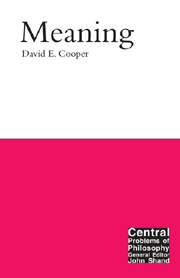2 - The reach of meaning
Summary
The title of this chapter is a pun. In its first section, I want to convey the reach of meaning in the sense of its scope or extent, to draw attention to the many contexts and ways in which, and the many types of item of which, meaning is predicated. There is, however, another, albeit obsolete, sense in which to have the reach of something is to comprehend or get the measure of it. A later section of the chapter, accordingly, attempts a preliminary and general understanding of the phenomenon whose immense scope will already have been indicated. We want, as it were, to get something of very great reach within our reach.
Frames, focuses and fields
One task for an enquiry into the meaning of meaning, we saw in Chapter 1, is to gain a perspicuous overview of the behaviour of “meaning” and cognate and related terms. Here I shall attempt something less ambitious, for even to illustrate, let alone taxonomize, the many ways in which those terms behave would be a long and gruelling job. That writers have turned up 16 or more alleged meanings of “meaning” – and then only in the domain of linguistic meaning – is some indication of the size of that job. (In what follows, I should stress, I do not assume that the distinctions I draw are best described as ones between different senses of “meaning”.) My concern is more with the appropriate response to the reach of meaning than to draw a comprehensive map of it.
- Type
- Chapter
- Information
- Meaning , pp. 16 - 39Publisher: Acumen PublishingPrint publication year: 2003



